Chicken Chow Mein Casserole
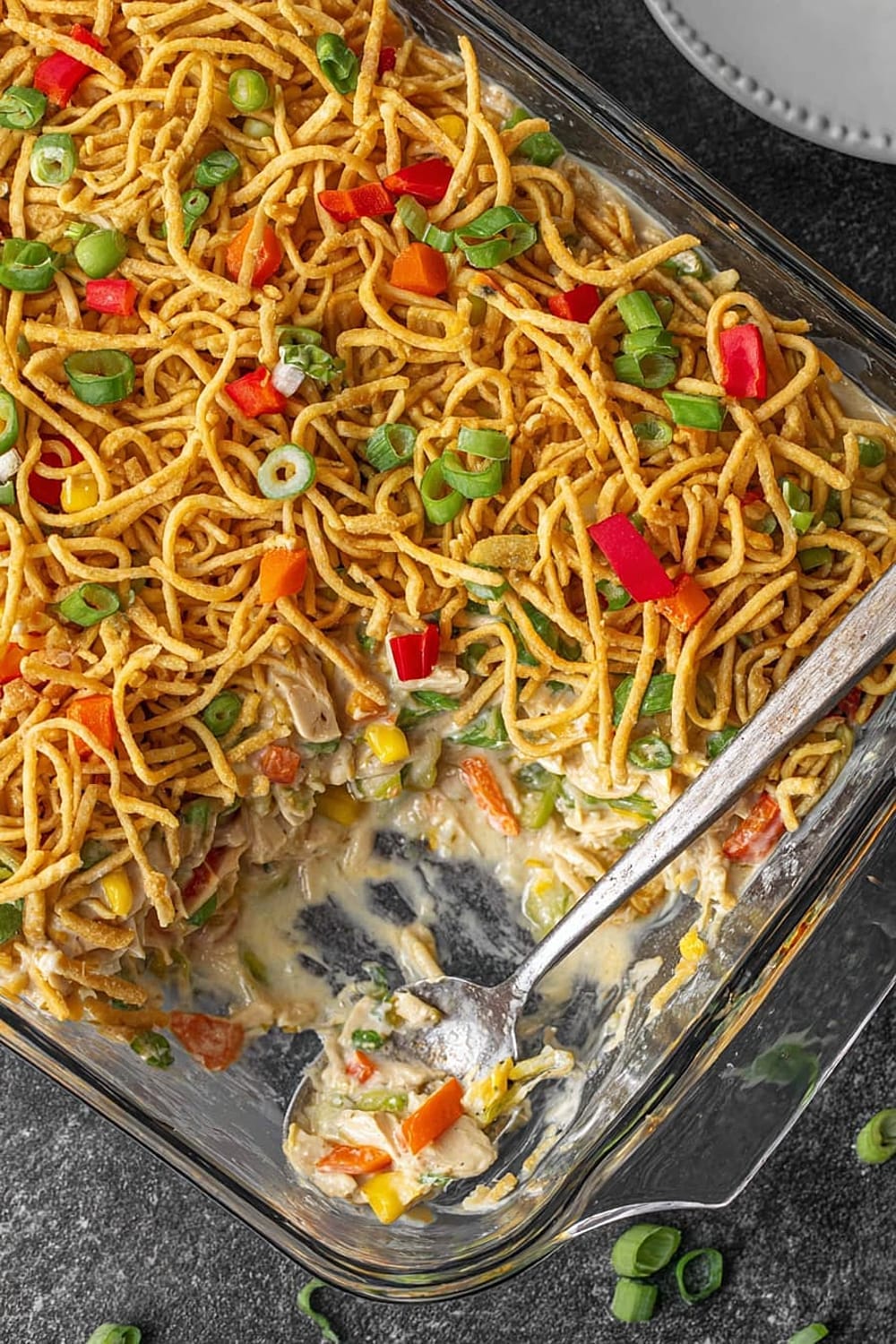
This casserole is basically what happens when your favorite Chinese takeout decides to get cozy with comfort food – and honestly, it’s a match made in heaven.
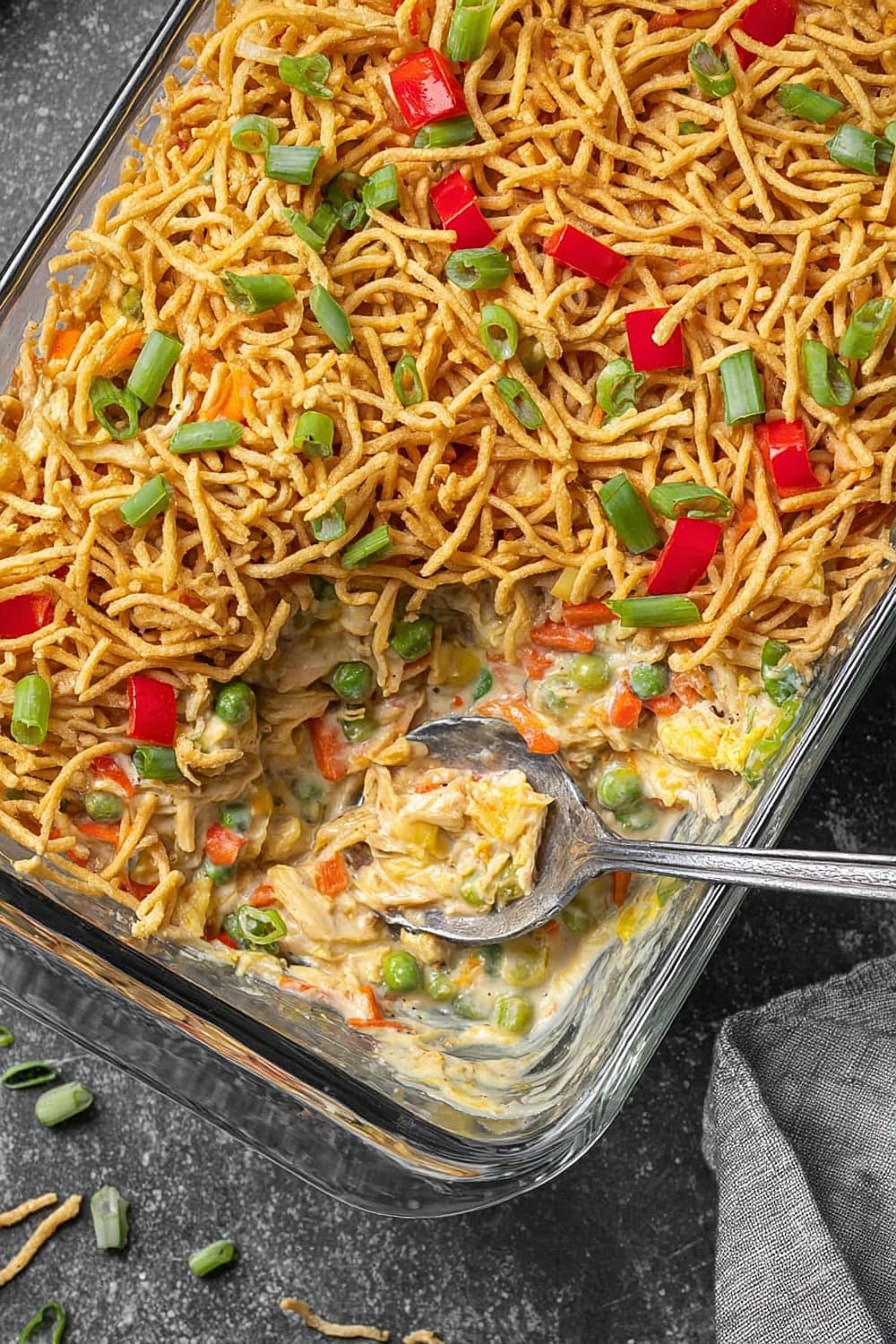
Picture crispy chow mein noodles creating the perfect golden crown on top of tender vegetables and succulent chicken, all swimming in a creamy, savory sauce that’ll make you question why you ever bothered with delivery.
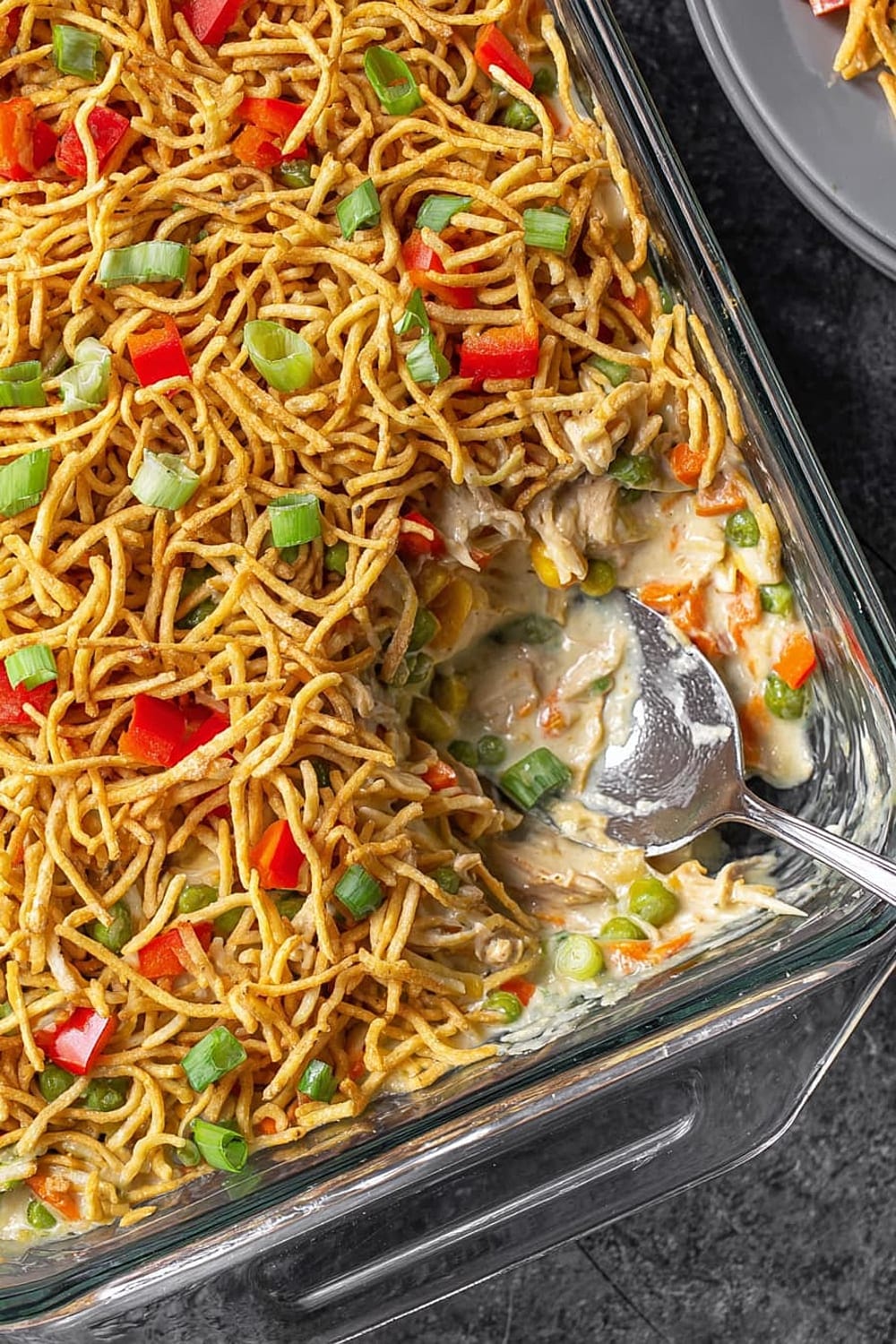
The beauty of this dish lies in its sneaky simplicity – you get all those complex Asian-inspired flavors without the fuss of stir-frying or the guilt of ordering out for the third time this week.
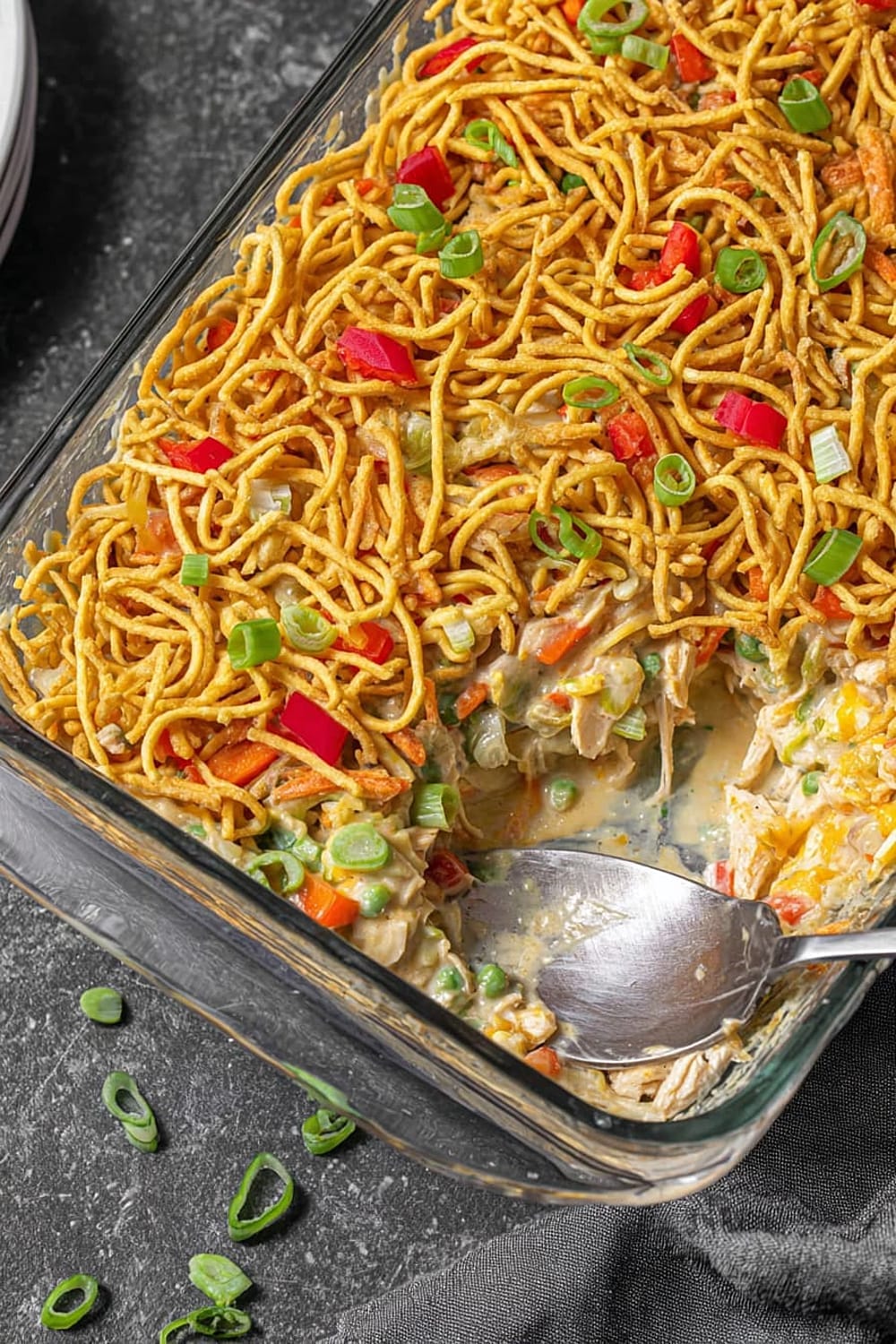
Every forkful delivers that satisfying crunch from the noodles, followed by the comforting creaminess of perfectly seasoned chicken and vegetables that have been cooked to tender perfection.
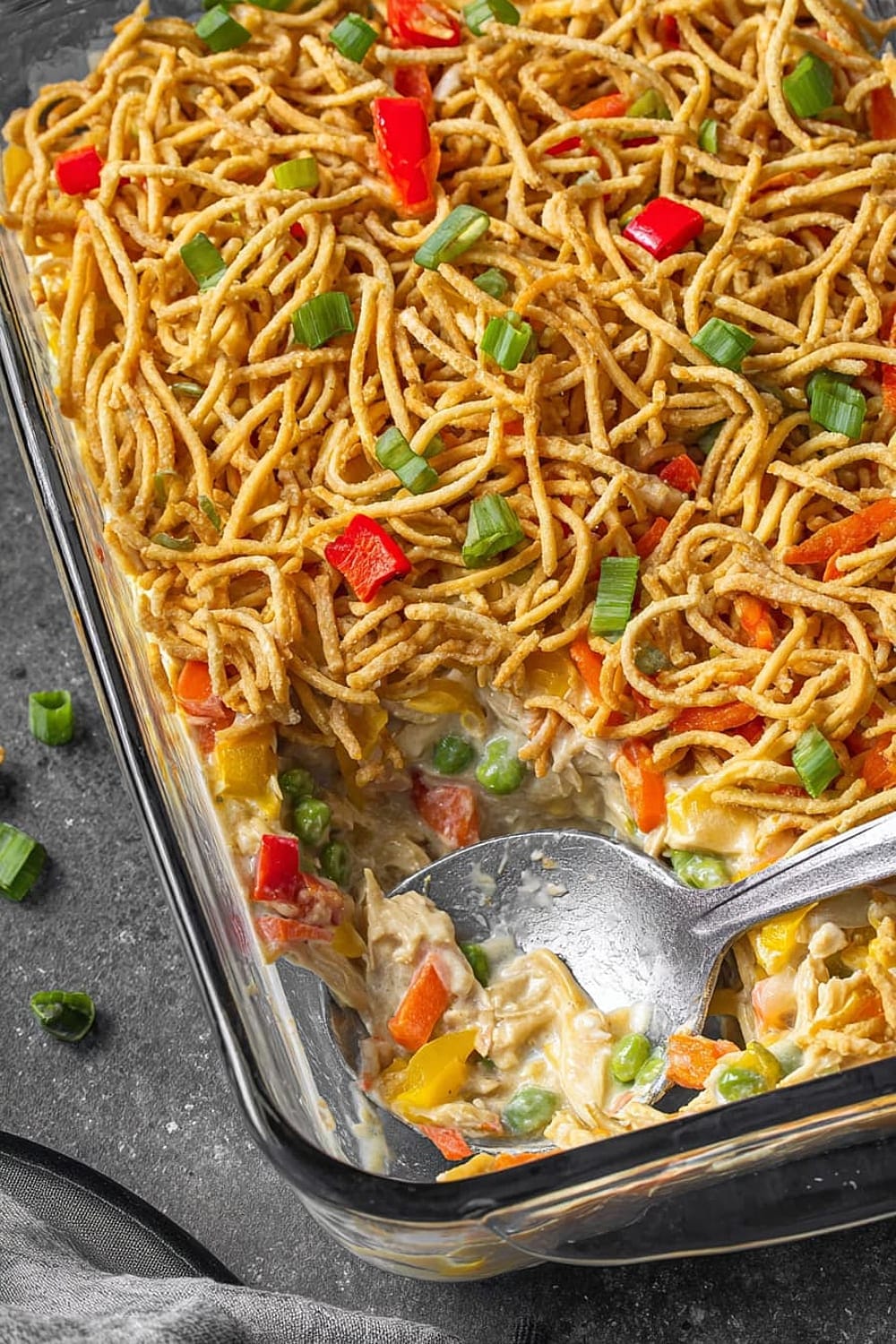
This is the kind of recipe that transforms your kitchen into the neighborhood’s most popular dinner destination, especially when that irresistible aroma starts wafting through the house.
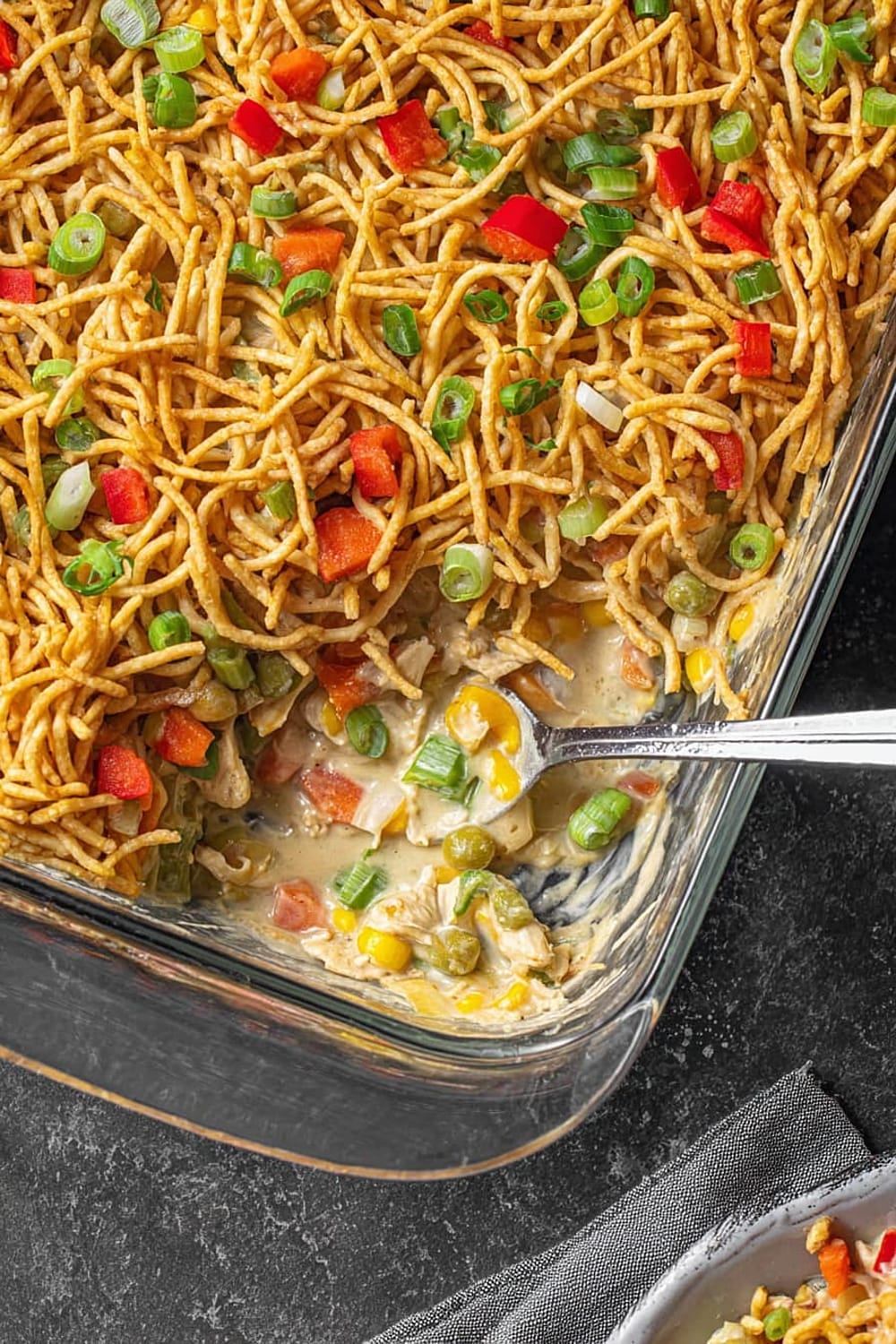
Warning: making this will result in people asking for the recipe, showing up “unexpectedly” around dinnertime, and possibly camping out in your kitchen until you agree to make it again.
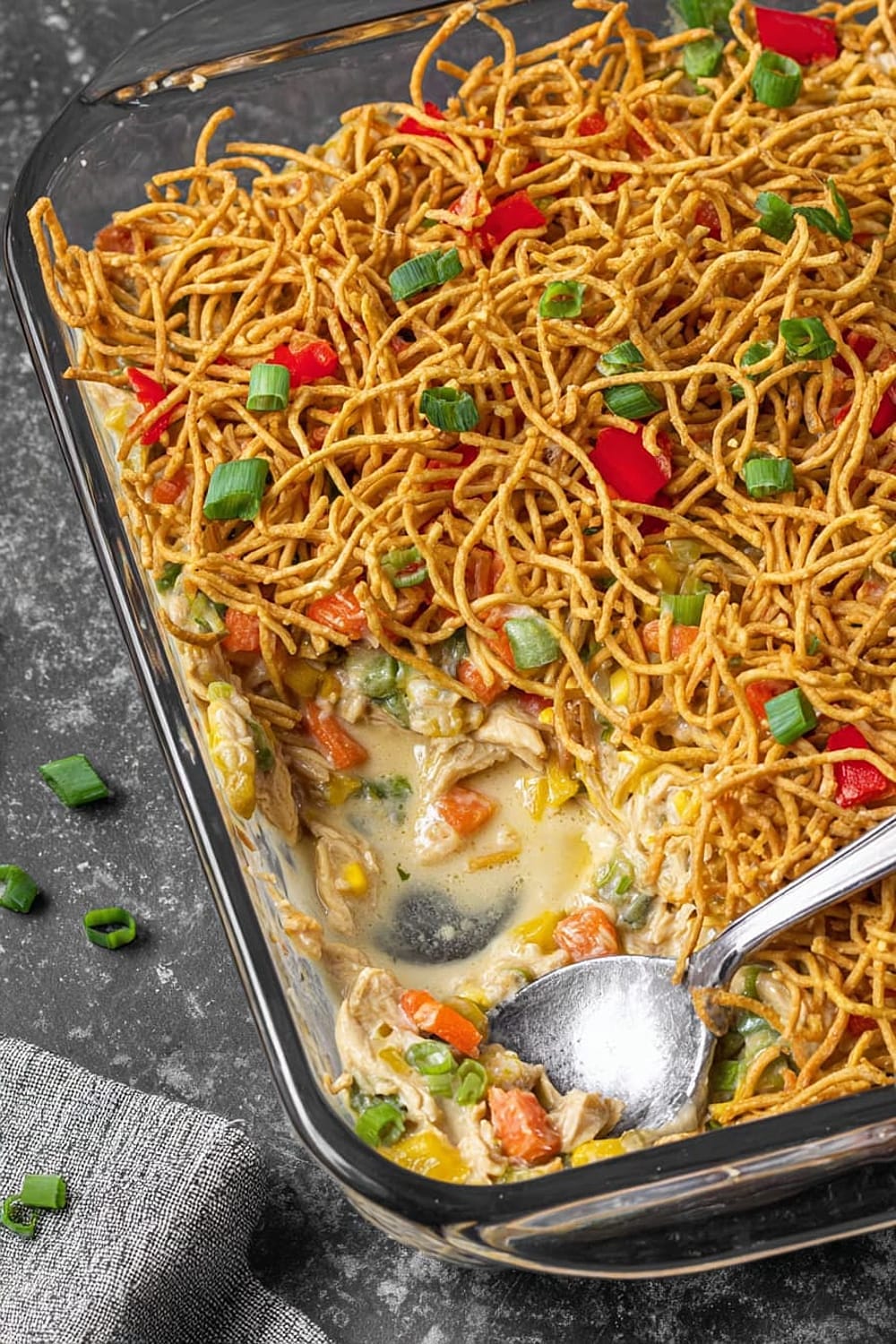
Ingredients
For the vegetable base
- 3 Tbsp unsalted butter
- 3 ribs celery, medium-large, sliced
- 3 carrots, medium-large, peeled and julienned
- 1 large red bell pepper, deseeded and chopped
- 1 medium yellow onion, peeled and diced
- 3 cloves garlic, crushed
For the creamy sauce
- 21 oz condensed cream of chicken soup (2 – 10.5 oz cans)
- 1 cup milk
- 1 Tbsp soy sauce
- ¼ tsp black pepper
For the filling
- 4 cups chicken, cooked and chopped
- 3 cups cooked rice (1 cup uncooked rice equals 3 cups cooked)
- 2½ cups chow mein noodles
Instructions
Preparation
- 1 Preheat your oven to 375°F (190°C) and lightly spray the inside of a 9×13-inch casserole dish with cooking spray. This prevents sticking and makes cleanup infinitely easier – trust me on this one.
- 2 If you’re starting with uncooked rice, prepare 1 cup of uncooked rice according to package directions to yield 3 cups of cooked rice. Day-old rice actually works better here since it’s less sticky and holds its shape during baking.
Building the vegetable base
- 3 Add 3 tablespoons of unsalted butter to a large, deep cast iron skillet over medium heat. Once the butter has completely melted and begins to foam slightly, add the celery, carrots, red bell pepper, and onion. Immediately turn the heat up to high – this initial blast of heat helps the vegetables retain their texture.
- 4 Cook the vegetables, stirring constantly with a wooden spoon or silicone spatula, until they’re starting to soften but still have a slight bite, about 3-5 minutes. You’ll know they’re ready when the onions become translucent and the carrots brighten in color.
- 5 Turn the heat back down to medium to prevent the garlic from burning. Add the crushed garlic and cook for exactly 30 seconds, stirring constantly. The garlic should become fragrant but not brown – burnt garlic will make the entire dish bitter.
Creating the sauce
- 6 Add the condensed cream of chicken soup, milk, soy sauce, and black pepper to the skillet. Use a whisk to combine everything smoothly, breaking up any lumps from the condensed soup. The mixture should be creamy and uniform in color.
Final assembly
- 7 Stir in the 4 cups of cooked chicken and 3 cups of cooked rice until everything is evenly distributed and well-coated with the creamy sauce. The mixture should look cohesive but not soupy.
- 8 Transfer the entire mixture to your prepared casserole dish, using a large spoon to spread it evenly. Distribute the 2½ cups of chow mein noodles evenly across the top – this creates that signature crunchy layer that makes this casserole special.
Baking to perfection
- 9 Cover the dish tightly with aluminum foil to prevent the noodles from over-browning and to ensure even heating throughout. Bake for 30 minutes, until the casserole is heated through and bubbling around the edges.
- 10 Serve immediately, topped with sliced scallions and minced red bell pepper for a fresh color contrast and added crunch.
Recommended Equipment and Kitchen Tools
Essential Tools (for best results)
- Large cast iron skillet or deep sauté pan – The heavy bottom distributes heat evenly and prevents the vegetables from burning during the high-heat sautéing phase
- 9×13-inch casserole dish – Glass or ceramic works best for even baking and easy monitoring of browning
- Silicone spatula – Perfect for stirring the creamy mixture without scratching your cookware
- Sharp chef’s knife – Essential for efficiently julienning carrots and dicing vegetables uniformly
Helpful Upgrades
- Kitchen scale – For precise measurements, especially when scaling the recipe up or down for different crowd sizes
- Mandoline slicer – Creates perfectly uniform vegetable cuts that cook evenly and look professional
- Instant-read thermometer – Ensures the casserole reaches 165°F (74°C) throughout for food safety
- Quality cutting board – A large wooden or bamboo board gives you plenty of space for prep work
Nice-to-Have Options
- Food processor – Makes quick work of chopping vegetables if you’re making multiple batches for meal prep
- Aluminum foil – Heavy-duty foil prevents tearing and provides better heat distribution during baking
Recipe Variations and Dietary Modifications
Gluten-Free Adaptation
- Replace chow mein noodles with gluten-free crispy rice noodles or crushed gluten-free crackers
- Use gluten-free cream of chicken soup (many major brands now offer this option)
- Verify that your soy sauce is gluten-free or substitute with tamari or coconut aminos
- The texture remains virtually identical with these swaps
Dairy-Free Modifications
- Substitute butter with 3 tablespoons of olive oil or vegan butter
- Replace milk with unsweetened coconut milk or oat milk for creaminess
- Use dairy-free cream of chicken soup or make your own with coconut milk and chicken broth
- Add an extra 1 tablespoon of soy sauce to compensate for flavor depth
Low-Carb/Keto Version
- Replace rice with 3 cups of cauliflower rice, squeezed dry after cooking
- Use pork rinds or crushed almonds instead of chow mein noodles for the crunchy topping
- This modification reduces carbs by approximately 75% while maintaining the comfort food appeal
Flavor Variations
- Mushroom lovers: Add 8 oz sliced button mushrooms with the vegetables and use cream of mushroom soup
- Spicy version: Include 1 teaspoon crushed red pepper flakes for heat
- Asian fusion: Add 1 tablespoon sesame oil and 2 teaspoons fresh ginger with the garlic
Nutritional Information and Health Benefits
Key Nutritional Highlights
This hearty casserole provides approximately 577 calories per serving, making it a substantial main dish that satisfies without being overly heavy. Each serving delivers a balanced combination of lean protein from the chicken, complex carbohydrates from the rice, and essential vitamins from the colorful vegetable medley. The dish provides approximately 35 grams of protein per serving, supporting muscle maintenance and satiety.
Health Benefits of Main Ingredients
The bell peppers and carrots are powerhouses of vitamin A and C, supporting immune function and eye health. These vegetables also provide beta-carotene, a potent antioxidant that helps protect cells from damage. The celery adds fiber and potassium, which supports heart health and proper muscle function. Garlic contains allicin, a compound with natural antibacterial properties and potential cardiovascular benefits.
Dietary Considerations
This recipe contains dairy (milk and butter) and gluten (potentially in the soup and noodles), making it unsuitable for those with these allergies without modifications. The dish is naturally nut-free and can easily accommodate various dietary restrictions with simple substitutions. Each serving provides approximately 15% of daily fiber needs and 40% of daily protein requirements for the average adult.
Smart Swaps and Ingredient Substitutions
Common Substitutions:
- Cream of chicken soup → Cream of mushroom soup (1:1 ratio) for deeper umami flavor
- Milk → Heavy cream (reduces quantity to ¾ cup) for richer texture
- Chow mein noodles → Crushed ramen noodles or dried egg noodles for similar crunch
- Fresh garlic → 1 teaspoon garlic powder when fresh isn’t available
Budget-Friendly Swaps:
- Rotisserie chicken → Leftover turkey or canned chicken (drained and flaked)
- Fresh vegetables → Frozen mixed vegetables (thaw and drain first)
- Butter → Vegetable oil (use 2 tablespoons instead of 3)
Pantry Emergency Substitutions:
- Condensed soup → 2 cups chicken broth + ¼ cup flour whisked together and simmered until thick
- Soy sauce → Worcestershire sauce (use half the amount) for similar umami depth
- Rice → Cooked pasta or quinoa for different textures and nutritional profiles
Pro Tips for Substitutions:
- Store leftover chow mein noodles in an airtight container for up to 2 weeks
- When using frozen vegetables, increase cooking time by 2-3 minutes to remove excess moisture
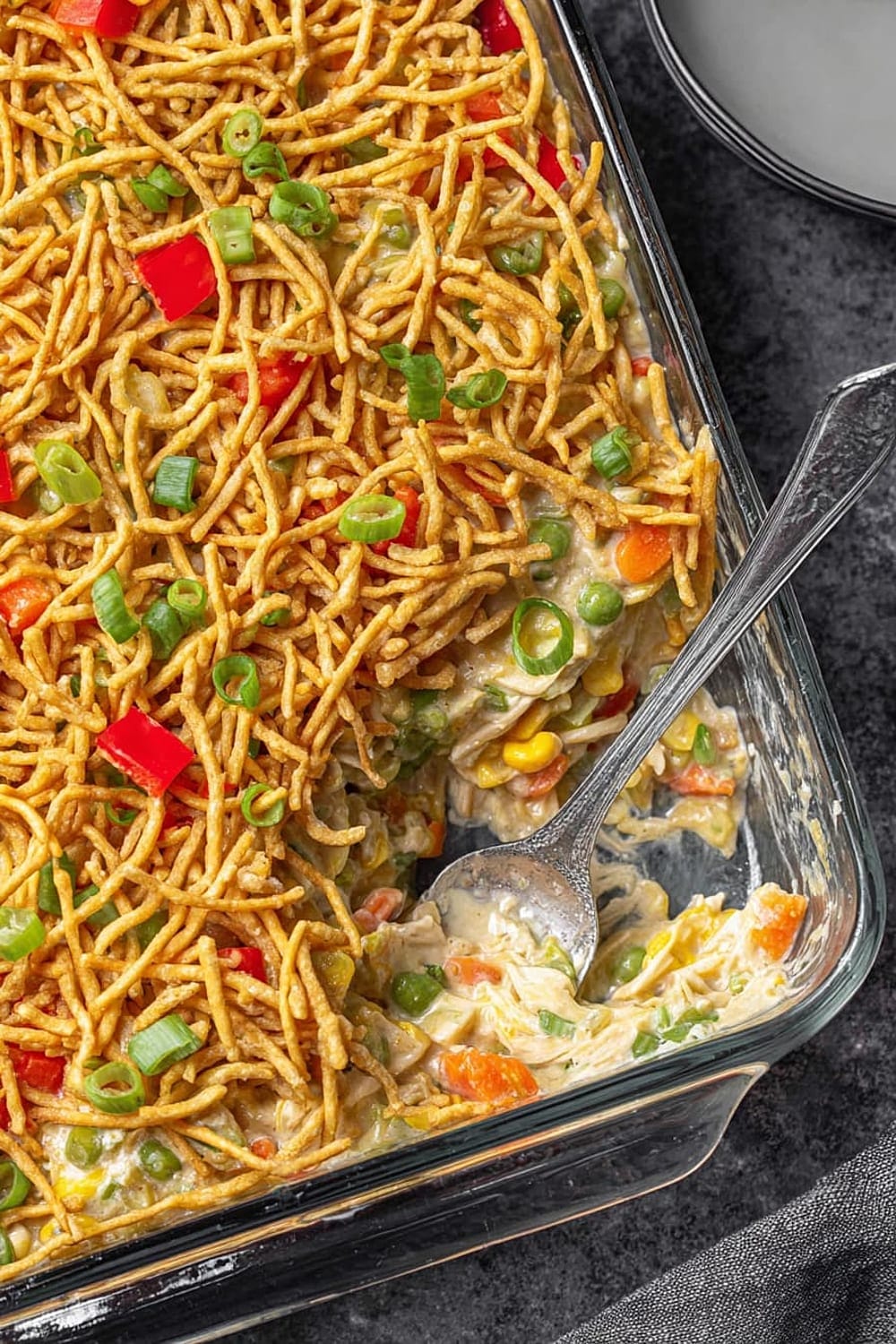
Make It Diabetes-Friendly
Carb Modifications:
- Replace 3 cups rice with 3 cups cauliflower rice to reduce carbs by approximately 40 grams per serving
- Use sugar-free cream of chicken soup if available, or make homemade with low-sodium broth
- Substitute chow mein noodles with crushed almonds or pork rinds for crunch without carbs
Portion & Timing Tips:
- Reduce serving size to 1 cup and pair with a large green salad to maintain satisfaction
- Estimated carb content with modifications: 15-20 grams per serving versus original 45 grams
- Serve with grilled vegetables or steamed broccoli to add volume without carbs
Blood Sugar Management:
- The high protein content helps slow carb absorption when rice is included
- Adding 1 tablespoon of fiber-rich chia seeds to the mixture can further moderate blood sugar response
- Consider serving smaller portions as a side dish rather than main course
Total Carb Reduction: Modified version contains approximately 65% fewer carbs than the original recipe while maintaining the comfort food satisfaction.
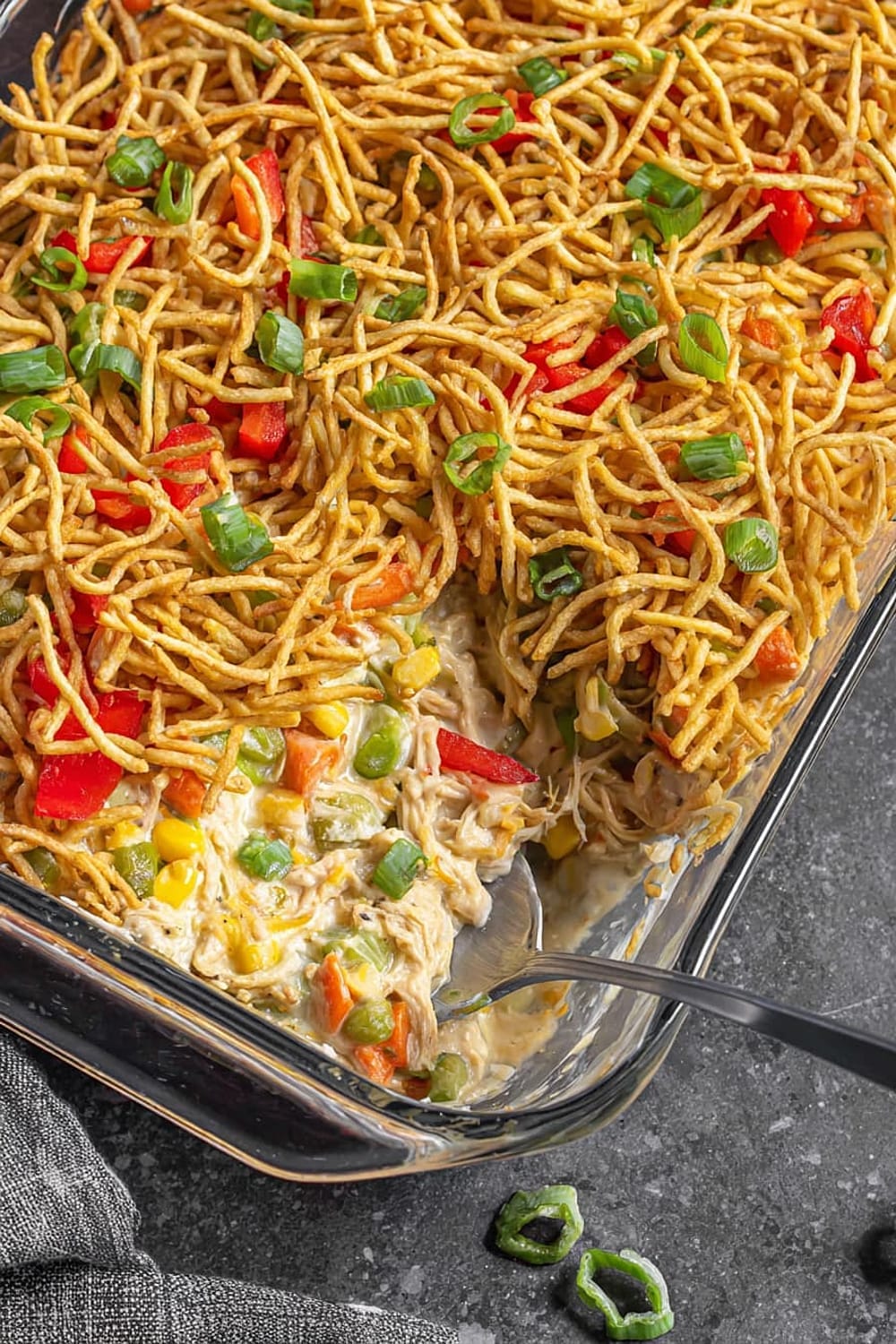
Perfect Pairing Suggestions
Beverage Pairings
A crisp Riesling or Pinot Grigio complements the creamy richness while cutting through the butter-based sauce beautifully. For beer lovers, a light lager or wheat beer provides the perfect refreshing contrast to this hearty casserole. Non-alcoholic options include jasmine tea or sparkling water with lime, which cleanse the palate between bites and enhance the Asian-inspired flavors.
Side Dish Recommendations
Steamed edamame with sea salt adds protein and a pop of bright green color to your plate. Asian cucumber salad with rice vinegar dressing provides a cool, crisp contrast to the warm, creamy casserole. Roasted bok choy with garlic maintains the Asian theme while adding beneficial greens. For a heartier meal, serve with pot stickers or spring rolls as appetizers.
Complete Meal Ideas
Start with hot and sour soup or wonton soup to set the Asian fusion theme. The casserole serves as an excellent main course for family gatherings or potluck dinners. Finish with fortune cookies and fresh fruit like sliced oranges or pineapple for a light, refreshing dessert that doesn’t compete with the rich main dish.
Occasion Suggestions
This casserole shines at casual dinner parties, church potlucks, and weeknight family dinners. It’s particularly perfect for meal prep Sundays since it reheats beautifully and tastes even better the next day. The comfort food appeal makes it ideal for cold weather entertaining or when you need to feed a crowd without stress.
Pro Tips and Troubleshooting
Professional Techniques
Pre-cook your vegetables until they’re just 80% done – they’ll finish cooking in the oven without becoming mushy. Use day-old rice whenever possible, as fresh rice can become gummy when baked. For extra flavor depth, toast the chow mein noodles in a dry skillet for 2-3 minutes before adding them to the top of the casserole.
Common Mistake Prevention
Don’t skip the high-heat vegetable sautéing step – this caramelization adds crucial flavor that can’t be achieved by simply mixing everything together. Avoid over-mixing once you add the rice and chicken, as this can break down the rice grains and create a mushy texture.
Storage and Reheating
Store leftovers in the refrigerator for up to 4 days in airtight containers. Reheat individual portions in the microwave at 50% power for 2-3 minutes, stirring halfway through. For oven reheating, cover with foil and warm at 325°F (163°C) for 15-20 minutes.
Make-Ahead Strategies
Assemble the entire casserole up to 24 hours ahead, but add the chow mein noodles just before baking to maintain their crispness. The flavors actually improve overnight, making this an excellent do-ahead option for entertaining.
Recipe Scaling
This recipe doubles perfectly for large gatherings – use two 9×13-inch dishes rather than one larger pan for even cooking. When halving, use an 8×8-inch square pan and reduce baking time to 25 minutes.
There you have it – a casserole that proves you can have your takeout flavors and eat them too, all while wearing your favorite sweatpants and never leaving the house. This is comfort food that doesn’t compromise on flavor, and honestly, that’s the kind of win we all need in our lives. Your family will think you’ve unlocked some secret culinary code, but we both know the real secret is just following a great recipe and not overthinking it.